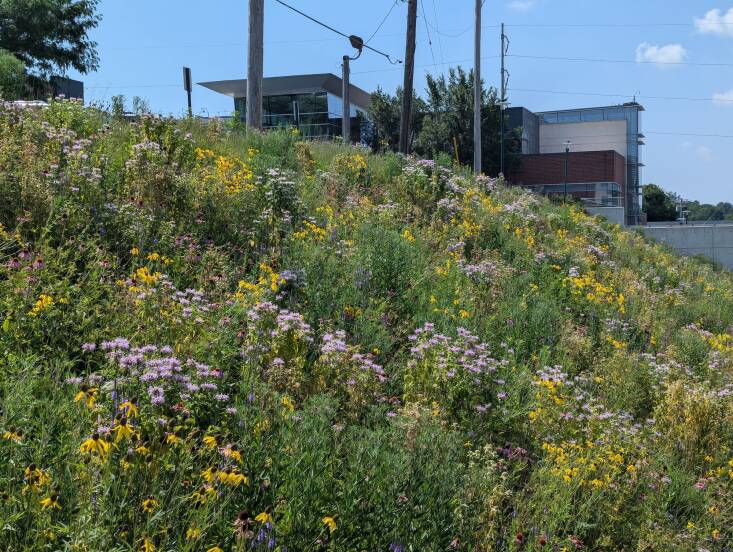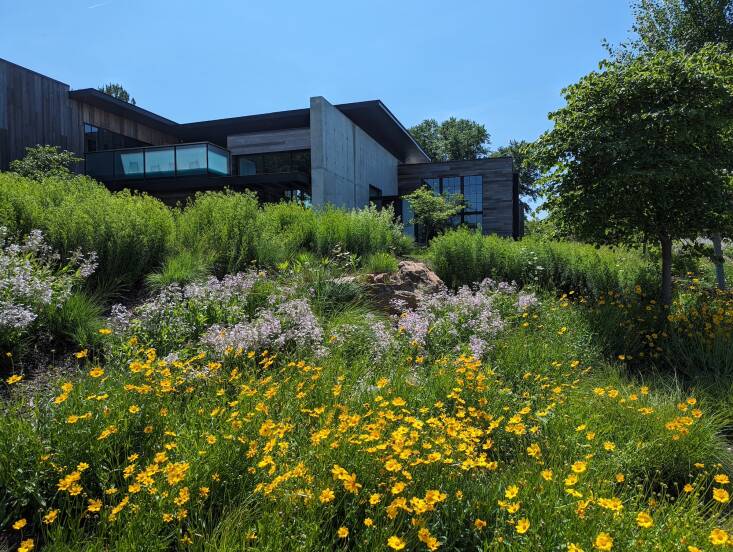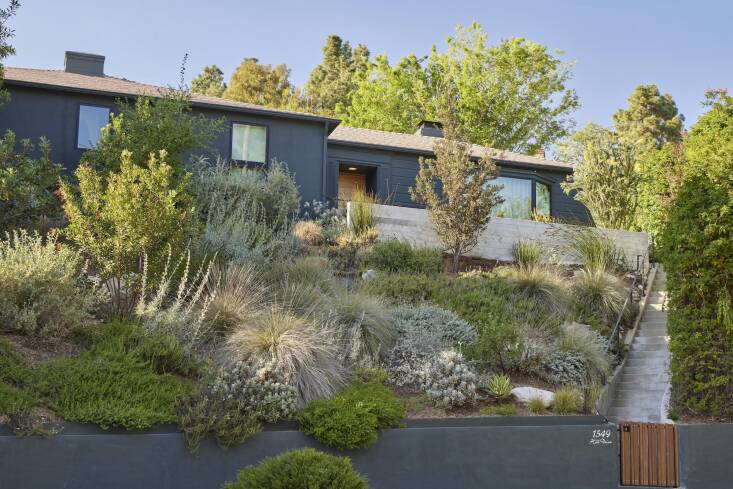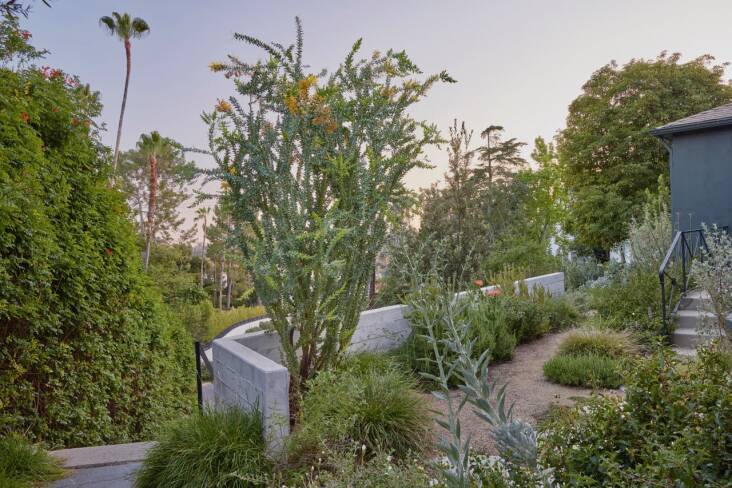A steeply pitched lot can present a challenge for even the most seasoned garden designer. Many resort to terracing the slope to create flat ground to work within, but moving that much earth is expensive–and it deeply disturbs the site. We spoke to three garden designers who created diverse gardens on very sloped sites to learn how they handled this particular challenge. Below, these experts share their best tips, from figuring out what plants will thrive to how to keep the soil in place during establishment.
Use a “cover crop” to prevent erosion.
Above: Because of heavy invasive weed pressure, Refugia planted only grass species in the first phase of this project. This included seeding a mix of fine fescue and annual rye, before planting warm-season ornamental grasses like big bluestem, switchgrass, and little bluestem. Once weeds were under control, they added flowering perennials. Photograph by Kayla Fell, courtesy of Refugia Design.
When reimagining a residential sloped yard in Pennsylvania, Refugia Design Build first removed overgrown shrubs and a ton of invasive English ivy, leaving a lot of exposed earth. Knowing that preventing erosion would be key in the first year, they strategically seeded a mix of fine fescue and annual rye. “The annual rye served as a fast-germinating winter cover crop—a temporary tool that allowed us to get almost instant erosion control while waiting for the fescue to germinate and the rest of the plantings to be completed,” says landscape designer Amanda Branum, who was the design lead for this project. Branum notes they cut back the rye before it went to seed the following spring.
Pay attention to root structure.
California-based landscape designer Fi Campbell says she focussed on plants with “distinguished roots,” to hold the soil on the slope of a residential property in Los Angeles. In her climate, that meant native bunch grasses and Muhlenbergia (muhly grass), which have deep root systems. Campbell also used ground covers like creeping sages and coyote bush for stabilization. Shrubs, including toyon, manzanita, and various different buckwheat, help anchor the garden. Tip: Prairie Moon Nursery includes images of root structures for all the seeds and plants it sells, if you need help visualizing roots.
Kill the weeds—then leave them.
 Above: Vogt says this hill at the University of Nebraska was a great chance to “show what we could do with urban lawn spaces we don’t use that still need to be maintained with mowers.” Photograph by Benjamin Vogt, courtesy of Prairie Up.
Above: Vogt says this hill at the University of Nebraska was a great chance to “show what we could do with urban lawn spaces we don’t use that still need to be maintained with mowers.” Photograph by Benjamin Vogt, courtesy of Prairie Up.
Both Refugia and garden designer Benjamin Vogt, the founder of Prairie Up in Nebraska, used one-time applications of short-lasting herbicide to kill the existing vegetation on the site–and then left the dead grass and weeds in place. Using herbicides felt like the right choice because it caused less disturbance and erosion than manually removing vegetation. “Dead lawn also does a good job holding things in place,” adds Vogt, who was working with a former expanse of turf grass on a university campus. Branum describes the dead vegetation as “a natural erosion blanket,” noting that as it decomposed on her project, rye and fescue seeds germinated and held the soil in place while slower-growing plants filled in.
Focus on native plants.
All three experts we spoke to worked with a palette of primarily native plants. Because these species are well-suited to their greater environment, they’re naturally resilient. “Natives tend to root themselves really well. There’s less chance of losing them in the first phases of planting,” says Campbell.
Work with young plants.
 Above: This residential project by Vogt was planted entirely from landscape plugs. He selected a monoculture grass matrix of Carex vulpinoidea with just a few species of forbs interspersed in large drifts. Vogt notes he would not usually have chosen the Carex vulpinoidea for a sunny slope, but he knew the clients would be watering nearby trees, so it could establish well. Photograph by Benjamin Vogt, courtesy of Prairie Up.
Above: This residential project by Vogt was planted entirely from landscape plugs. He selected a monoculture grass matrix of Carex vulpinoidea with just a few species of forbs interspersed in large drifts. Vogt notes he would not usually have chosen the Carex vulpinoidea for a sunny slope, but he knew the clients would be watering nearby trees, so it could establish well. Photograph by Benjamin Vogt, courtesy of Prairie Up.
Garden designers always love landscape plugs and smaller plants for their budget-friendliness, but they are also easier to plant in a challenging hillside setting. That said, you’ll need patience going this route, Campbell acknowledges. “I like to use some five and 15 gallon species [along with one-gallon size], so that there’s some height and oomph to the palette right away.”
Choose trees wisely.
 Above: On this sloped landscape designed by Refugia, small trees flank an organic staircase featuring boulders and Pennsylvania bluestone. “It feels like it’s been a part of the hillside forever,” says Branum. Photograph by Kayla Fell, courtesy of Refugia Design.
Above: On this sloped landscape designed by Refugia, small trees flank an organic staircase featuring boulders and Pennsylvania bluestone. “It feels like it’s been a part of the hillside forever,” says Branum. Photograph by Kayla Fell, courtesy of Refugia Design.
Selecting trees appropriate to your conditions is especially important on a slope. For example, Refugia chose trees that could tolerate rocky, dry soil and that are adapted to disturbed areas, like Eastern red cedar, for their hillside project. Branum notes that smaller trees are also easier to plant on a hill: “We were careful to purchase trees that were not too large for us to handle on the steep slope.”
Create planting shelves.
Campbell advises that you need to take care with your technique when planting into a hillside. “You have to scoop out a flat zone, to create a reservoir to catch the water–every plant needs to have a little plateau and a reservoir,” she says. To create these “planting shelves,” you will dig into the hillside to carve out a flat area for the plant; then place the excess soil downhill creating a berm-line ledge.
Use boulders to slow water flow.
 Above: Instead of terracing, which a lot of the neighboring properties had done, Campbell designed a landscape with boulders and native plantings that had distinguished root systems, so she could rely on the natural planting to deal with the erosion control and stability. Photograph by Caitlin Atkinson, courtesy of Fi Campbell Design.
Above: Instead of terracing, which a lot of the neighboring properties had done, Campbell designed a landscape with boulders and native plantings that had distinguished root systems, so she could rely on the natural planting to deal with the erosion control and stability. Photograph by Caitlin Atkinson, courtesy of Fi Campbell Design.
Campbell incorporated boulders into her design to help direct the flow of water when it rains. “They create a filtration system of sorts,” she explains. “There’s a flatter zone right behind them that water would hit and it wouldn’t just immediately go downhill. Instead it sits behind the boulders and permeates into that area and then drains down to the lower level.” Campbell chose boulders that could be moved by three or four people with ropes and pulleys, since they didn’t use any machines.
“Right plant, right place” is even more important.
Take all of the conditions–not just the slope–into consideration when choosing plants. In addition to working with a sloped piece of land, Refugia’s clients had dry soil (a common occurrence in places where water naturally drains away). “We chose plants that would be drought-tolerant like St. John’s Wort, prairie grasses, and eastern red cedar,” says Branum.
Take advantage of flat areas.
 Above: Campbell’s Los Angeles clients wanted to create a safe entrance that was more welcoming for friends. Adding a board-form cement wall at the top of the hill allowed Campbell to create a garden at this home’s entrance. Photograph by Caitlin Atkinson, courtesy of Fi Campbell Design.
Above: Campbell’s Los Angeles clients wanted to create a safe entrance that was more welcoming for friends. Adding a board-form cement wall at the top of the hill allowed Campbell to create a garden at this home’s entrance. Photograph by Caitlin Atkinson, courtesy of Fi Campbell Design.
Both Campbell and Branum took advantage of flat areas at the top of the hill to create usable gardens. Campbell added a stem wall (stabilized with rebar) that they backfilled to expand the flat land by the house’s entrance.
Plan for extra labor.
Vogt notes that one of the biggest challenges for a hill sit is “just walking on the slopes, holding drills and drilling plugs.” Likewise, Campbell describes how every shrub and tree had to be maneuvered onto her site with ropes and pulleys, since using machines on the fragile hillside wasn’t an option.
See also:



